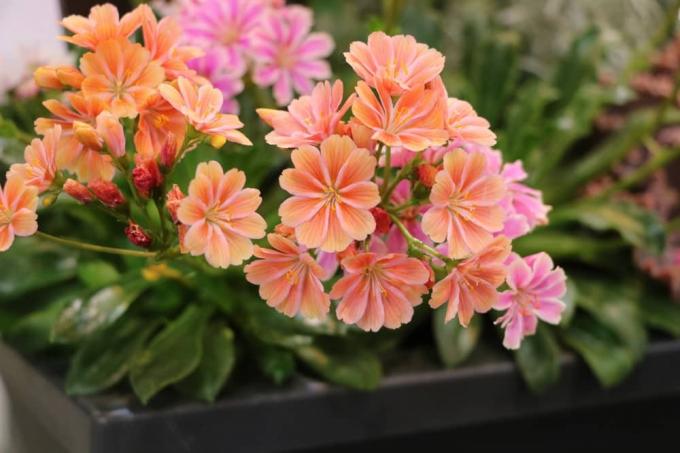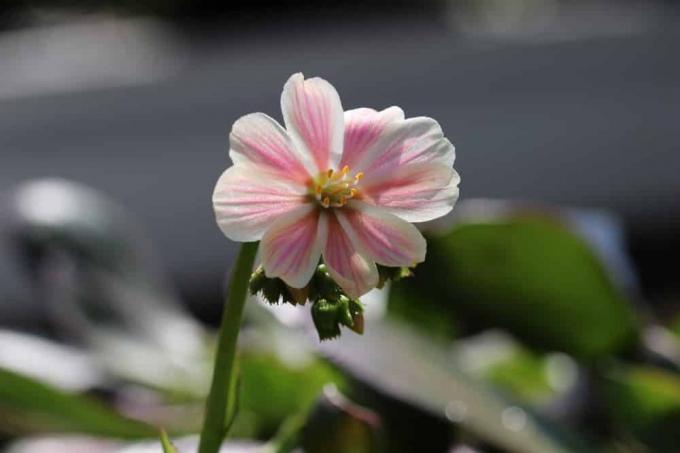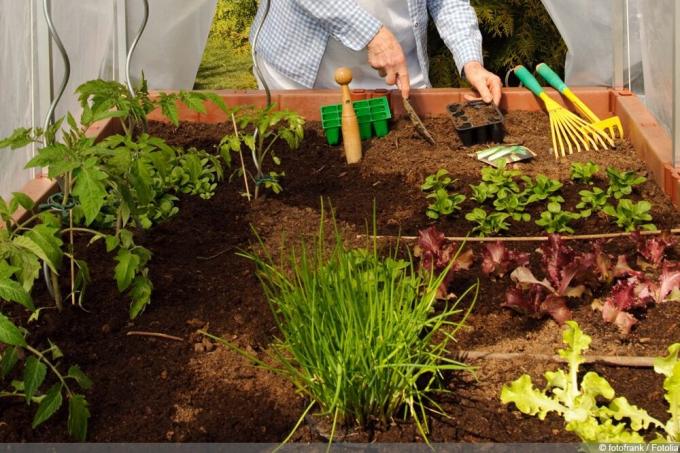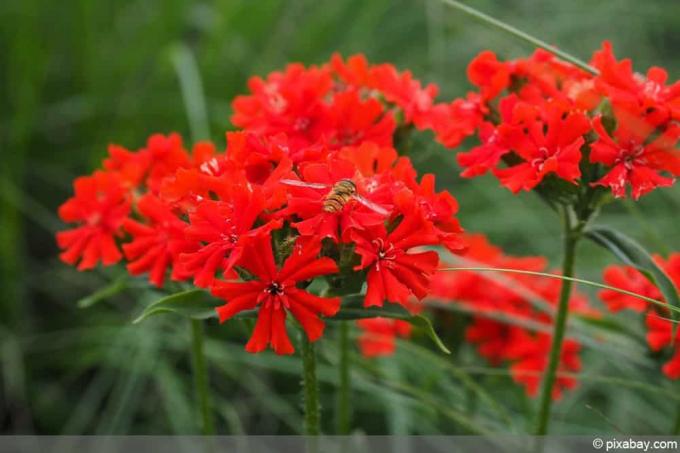

Table of contents
- Characteristics
- Sowing, planting, site selection
- Care Instructions
- Varieties, cultivars, more porcelain roses
Gardeners interested in the language are still amused by the blatantly contradictory names, while rock garden designers have long since started to use the “flowering stars”. decorate - quite large areas, because the porcelain roses are available in a wide variety of tones from white to yellow, orange, red, pink to the bluish range become. A skilful combination results in an orgy of colors that blooms for a long time and requires little care:
Characteristics
- The full name of the Lewisia cotyledon is "Common Bitterroot".
- It belongs to the order Carnations (like carnations, cacti, knotweed and 32 other plant families)
- Springwort family, whose other 14 genera contain rather unknown plants
- The genus Bitterwurz (Lewisia) itself comprises 17 species
- All of which are native to the mountainous western United States, Canada and Alaska
- The "Common Bitterroot" comes from the Southwest of the USA
- Where it grows almost exclusively on rocky ground, where the roots make their way through the cracks in the rock
- The rocky ground is usually in a coastal mountain range, where any excess wetness "can run off for miles"
- The soil and its composition therefore play a major role in the culture of the Lewisia
Sowing, planting, site selection
The common bitterroot does not belong to the “heavenly stormers”, even if individual cultivars stretch upwards. But the premise of the original – flower stalks on/from a basal rosette spreading its leaves flat on the ground – sets limits; no Lewisia cotyledon has ever managed to grow more than 40 cm in height.
The leaves are succulent and evergreen, they look pretty as a rosette anyway and with some variants/cultivars they also look really distinctive as a single leaf. However, the flowers are responsible for the actual show effects, which have given the natural species the name porcelain roses.
The small bitterroot needs an isolated spot on the ground or an elevated spot in a terraced rock garden. If possible at the front of the bed or on the edge of the bordering wall, so that the flowers really come into their own. There she can then show why she was given the "pet name" Porzellanröschen, and she likes to do that from May to July. Depending on the variety with racemose inflorescences between 10 and 30 cm high, which bear up to 50 small flowers close together.
The interesting thing about the flower is the petals, their color already varies in the natural species: Most porcelain roses develop pink to purple colored petals with light and/or dark stripes, but there are always "creative plant individuals" in between, which develop white, cream-colored, yellow or orange petals, with yellow-orange to reddish tints stripes.

The floor for these “color wonders” should be as similar as possible to the home floor. In this case, the home soil is on a rocky slope in southwestern Oregon or northwestern California, the soil in the rock garden is pretty close. A plantable natural stone wall is also a good place for porcelain roses, and they taller cultivars can also be planted in garden beds if their soil is very good are permeable.
Overall, it is important that the long, fleshy taproot finds enough loose soil to find its way into to pave the depth, in the rock garden/natural stone wall there must be enough soil mass between the stones condition. Waterlogging quickly causes problems for the porcelain rose, or causes the root neck to rot, so bitterroot will only do well in the garden if it is exceptionally well drained. Heavy, compacted soils are not tolerated in the long term; sufficient coarse sand or grit should be worked in here.
The pH values can range from normal to slightly acidic; the Lewisia does not tolerate too calcareous soil well. Although the "dream soil of the Lewisia" is interspersed with sand and stones, there should also be soil with a relatively large amount of humus and nutrients, as only this feeds bitterweed well.
The demands on light are not so extreme, partial shade is sufficient for the original species, while multicolored flower wonders such as L. cotyledon 'Sunset Strain' unfold more splendor with a little more sun. However, most evergreen Lewisias prefer semi-shade to (too) blazing sun; in the Rocky Mountains they grow on cliff faces to the east.
If there is a chance to plant porcelain roses in the sun and at the same time protected from the rain all year round, e.g. B. under a roof overhang, you should definitely seize this opportunity - the less water from above, the better. If no roofing is possible, the next best thing is to put bitterroot in the shelter of one to plant taller growing plants that are north-west (usual rain direction) from her stands.
Tip:
Porcelain rosettes in pots should be repotted or repotted immediately after purchase. plant in the garden soil. Because Lewisia cotyledon hybrids as bulk goods from the garden center/DIY store are usually in pure peat substrate. With a view to the lime content, that's not wrong, but peat substrate doesn't even begin to create the moisture balance that Porcelain florets need, but expose the bitterroot to permanent moisture around the root neck after each watering, which they do not last long tolerate. So get out of the pot, either into the appropriately prepared garden area or with porcelain roses for completely remove the upper two-thirds of the peat from the bucket culture and through coarse granite chippings substitute. The lower third of the root ball in the pot can be left untouched if there is drainage and drainage under the roots.
Lewisias are also easy to sow, you just have to be sure that the seeds of the cold germ have been stratified or keep them in the fridge for a while to prolong dormancy break. The sown seeds germinate reliably and should react very positively to germination accelerators with the plant hormone gibberellic acid.
Care Instructions
The small perennial can be planted from April, the recommended planting distance is 20 cm for normal Lewisia cotyledon, vigorous cultivars can be planted more generously, both are best planted in groups.

Pay a little attention to the moisture until it starts to grow; once the porcelain rose has taken root, it will usually grow happily without any maintenance. Keeping away too much water (which can only be done by properly preparing the site) is far more important than adding water. You really only need to water the succulents for a fairly long period of time then at some point you realize that the stored water supplies are running out and they will soon "flabby".
Winter wetness is the peculiarity of our climate, which has probably put an end to most of the Lewisians who did not successfully overwinter in Germany. If the bitterroot does not grow under a canopy and no canopy can be attached for the winter either, the first step is to properly lay down a good layer of gravel or grit or loose small pebbles and then observe if rainwater runs off fast enough to keep the root neck from rotting protection.
If this is difficult to observe at the given location or doubtful (and you may have already made your way down to rare Lewisia collector varieties, see below), you can ensure safe overwintering of your Bitterroot by planting them in pots and keeping them under a roof over the winter (a parapet, an eaves, a wide windowsill under a eaves).
As a rule, you do not need to worry about the frost hardiness, bitterroot are considered to be extremely frost hardy and are designated with winter hardiness zone 7 (= tolerate climates in which winter temperatures average down to -18 °C fall).
You can propagate your porcelain rosettes by rooted leaf or branch cuttings, lowering daughter rosettes, or by seeds. Self-collected seeds of the cold germ must go through a cold period before sowing; either sow again in the fall or keep the seeds in the fridge until spring. The young plants should be protected as well as possible from snails, which have a great appetite for the succulent parts of the bitterroot plant.

You can choose whether the bitterwurz is suitable for cultivation as a houseplant: according to Wikipedia (de.wikipedia.org/wiki/Gewohnliche_Bitterwurz) thrive Lewisia cotyledon not in indoor culture, see www.samen-seeds.de/Stauden/L-N/Lewisia-Bitterwurz-Lewisie/Lewisia-cotyledon-Sunset-Strain-Lewisie-Bitterwurz-Samen.html the L cotyledon 'Sunset Strain' recommended for culture in "planters of all kinds", according to de.hortipedia.com/wiki/Lewisia_cotyledon can also be used as a container plant and Pot plant to be cultivated. A picture search reveals an impressive number of Lewisias in pots or balcony boxes, so in principle the plant cannot be averse to the principle of pot culture. Wikipedia probably means "room culture in the narrower sense", plant culture in pots and only in pots room, while you have good chances with porcelain roses in bucket culture (partly in the room, as often as possible outside). have. Just don't forget to water bitterroot in the sun in winter, too, as soon as the temperatures are clearly in the plus range.
Varieties, cultivars, more porcelain roses
Lewisia cotyledon has evolved into three varieties, Lewisia cotyledon var. cotyledon, L. cotyledon var. heckneri and L. cotyledon var. howellii, from which many magnificent color variants and hybrids have been bred:
1. Lewisia cotyledon 'Alba' naturally bears white flowers
2. Lewisia cotyledon 'Blue Purple' Sometimes only pink "creates", but sometimes also a clear blue cast: nwwildflowers.files.wordpress.com/2011/03/img_0429lewisia.jpg
3. Lewisia cotyledon 'Elise' was bred by the Dutch company Floragran, which won the "Fleuro-Star Award" for her in 2012. No wonder, Elise shows a firework of colors. Elise is a warm germinator that is so easy to grow that it can e.g. B. can be cultivated on the balcony every year. Prefer at 20 to 22 degrees in the room or in the greenhouse, Elise flowers five to six months after sowing, with precise sowing from early spring to autumn.
4. Lewisia cotyledon 'Chocolate' is no less beautiful and no less colourful, but gentler, the 'Elise' for romantics
5. L cotyledon 'rainbow' was one of the exciting innovations in 1990, probably the first Bitterwurz that was "colorful". The simple to semi-double flowers, which are already striking in their quantity, look for a color family as a theme, here the whole range from red to blue
6. Lewisia cotyledon 'Sunset Strain' develops all shades of red in the world on rather long flower stalks, densely packed and with white accents
7. Lewisia cotyledon 'White Splendor' does not surpass 'Alba' in the abundance of flowers, but in the splendor and radiance of the individual flowers
Tip:
If you cannot offer porcelain roses dry areas/rock gardens, you could plant the original natural species instead of the modern hybrids. They are traded in all three variants, although certainly not in the nearest hardware store or supermarket. generally as a mass product, but from specialized nurseries. In a forum post, a gardener with 40 years of Lewisia experience reports on a robust, water-resistant, indestructible variety with differently shaped buds Rosettes and exclusively pink/white striped flowers and is annoyed that he later mixed up their good genetic material with DIY plants such as Sunset Strain and others. has watered down. This hardy Lewisie could be Lewisia cotyledon var. howellii act, which in nature also grows in forests, peppermint flowers in white-pink and idiosyncratic shaped rosettes are definitely on the photo wildgingerfarm.com/plant-list/plants-l/lewisia-cotyledon-var-howel.html (but the other natural forms should also be quite robust be).

Nature is wasteful and extremely creative, which is why in the North American distribution area have developed 17 Lewisias in the genus, which are different enough to be classified as a species. Most of them are cultivated underneath, again plants with funny quirks like the Lewisia brachycalyx, which retires completely after flowering and then more flowers every year for the next season brings. The Lewisia columbiana, which forms small cushions, is considered to be insensitive to moisture, but also not to be shocked by blazing sunshine; Lewisia longipetala develops cushions in several soft and light colored varieties such as 'Little Mango', 'Little Peach', 'Little Plum'; Lewisia rediviva is the only Lewisia that tolerates a calcareous substrate.
You may get these Lewisien and others. in the above-mentioned specialist nurseries, but also through societies or clubs of cactus and succulent friends such as the Deutsche Kakteengesellschaft e. V (www.dkg.eu) or the professional society other sukkulenten e. V (www.fgas-sukkulenten.de).
Tip:
If you miss explanations on the healing power of the Lewisia: Indians are said to have used certain bitterroot species medicinal purposes (and cooked and ate the roots, but this is known in our culture few; nobody here heals with lewisias, and probably nobody has eaten their roots either. The bitter root that you think of (if you miss information about the healing power) belongs to the yellow gentian "Gentiana lutea", a bitter root or fever root that has long been known and used by us.
 garden editorial
garden editorial I write about everything that interests me in my garden.
Find out more about B for hardware store

Plastic bed edging: the advantages and disadvantages of the bed border
In a well-kept garden, the bed edging provides the right framework for the creative planting plan. When selecting suitable materials, plastic is one of the many options. This guide offers a decision-making aid with fundamental pros and cons. Read about the advantages and disadvantages of a plastic border here.

Bed edging made of wood: bed border in the vegetable bed | 5 ideas
Wood is the perfect material for edging the vegetable patch. Close to nature, durable, timeless and in warm colors are just a few of the convincing properties. Be inspired by these 5 ideas on how to create imaginative wooden frames for your beds in the kitchen garden.

Bed edging made of stone: which stones for the bed border?
Can't decide which stones will stylishly accentuate the border of the bed? This guide takes you into the exciting world of diverse types of stone for tasteful bordering. You can find out here which stone gives your garden beds the right frame.

Types of flowers from A-Z: the encyclopedia with 50 types of flowers
Flowers adorn gardens and balconies with their diverse flower shapes and their impressive blaze of colour. The lexicon of the 50 types of flowers tells you which flowers are suitable for the shade and which need a lot of sun in order to bloom colorfully and plentifully. You will also find flowers for every season here.

Burning Love, Lychnis Chalcedonica - Care Guide
Boasting bright red flowers perched on taut stems, she lives up to her name. The impressive summer perennial Burning Love is frugal and undemanding at the same time. To ensure that a Lychnis chalcedonica thrives in beds and tubs, these care instructions explain all the relevant details in a compact and understandable way.

Bergenien, Bergenia - varieties and care instructions
As ornamental foliage plants, evergreen bergenias beautify the wintry garden and, as early bloomers, herald the approaching spring with decorative cup-shaped blossoms. Explore a selection of magnificent varieties here, some of which bloom twice a year and are also wonderfully suitable for vase decoration. Our care instructions explain practically how the undemanding Bergenia should be cultivated.



